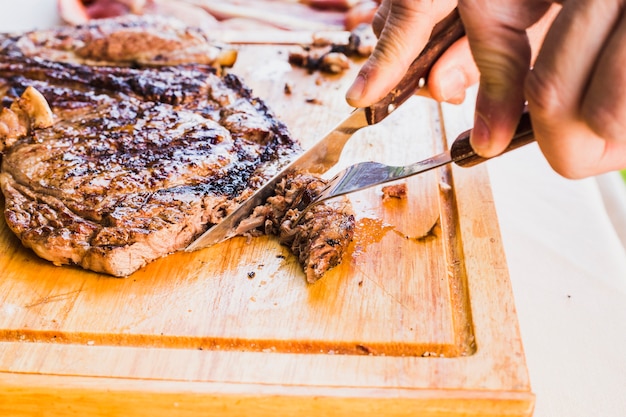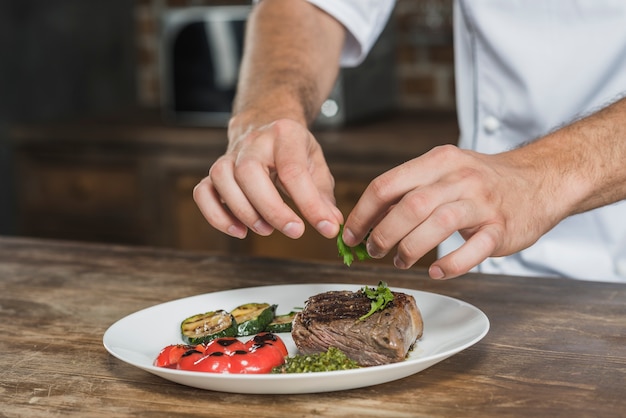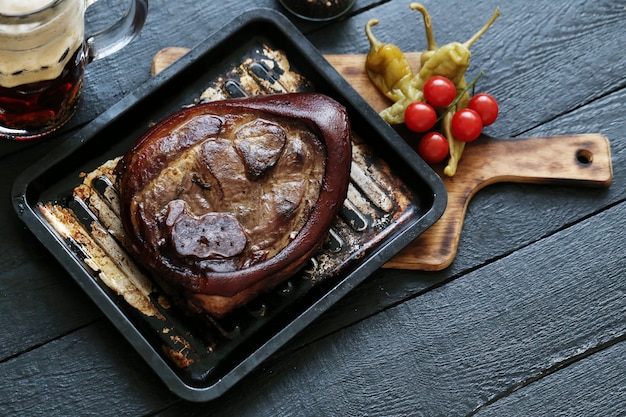(Part 1) Getting to Know Your Ribeye

The Crown Jewel of Steaks
The ribeye, also known as the "cowboy steak" in some parts, isn't just any cut of meat. It's a cut that commands attention. It comes from the rib section of the cow, right above the sirloin, and it's known for its generous marbling – those beautiful streaks of fat that run throughout the muscle. This marbling is the secret ingredient, the reason why ribeye is so incredibly flavorful and tender.
Why is Ribeye So Coveted?
Beyond its inherent deliciousness, ribeye is a blank canvas for culinary creativity. It shines on the grill, sizzles beautifully in a pan, and even lends itself to roasting. It's versatile, forgiving, and always delivers a satisfyingly rich taste experience.
(Part 2) choosing the right cut

Finding Your Perfect Match
The first step to a successful ribeye journey is choosing the right cut. This isn't just about grabbing the first steak you see; it's about finding a cut that speaks to your culinary ambitions. Head to your local butcher or the meat counter at the supermarket, and keep these key factors in mind:
- Marbling: The more, the merrier! Look for those creamy white streaks of fat, weaving throughout the muscle. It's what makes the ribeye so incredibly juicy and flavorful. A cut with good marbling will render beautifully during cooking, adding an extra layer of flavor and richness.
- Color: A bright, deep red hue is what you want to see. Avoid any cuts that appear greyish or have an unnatural color. This could indicate that the meat has been mishandled or stored improperly.
- Thickness: A good ribeye should be at least 1.5 inches thick. This allows for even cooking and prevents the steak from drying out. A thicker cut also provides a more satisfying eating experience.
- Bone-in or Boneless: This is a matter of personal preference. bone-in ribeye provides a more intense flavor and a more rustic presentation. Boneless ribeye is easier to handle and cook, particularly if you're grilling on a smaller surface.
Don't Be Shy About the Fat Cap!
You'll likely notice a layer of fat covering the top of the ribeye, known as the fat cap. This is a culinary treasure, not something to be trimmed away. The fat cap acts as a natural insulator, protecting the meat from drying out during cooking. As it renders down, it adds even more flavor and richness to your steak.
(Part 3) Preparing Your Ribeye for its Culinary Debut

The Power of Patting Dry
Once you've found your perfect ribeye, it's time to prepare it for its grand entrance. Start by patting it dry with paper towels. This seemingly simple step is crucial. By removing excess moisture, you ensure a better sear and a crispier crust, creating that mouthwatering contrast between a crunchy exterior and a juicy interior.
Seasoning – Less is More
Resist the urge to over-season! A good ribeye doesn't need a lot of fuss. Simple is best. A generous sprinkle of kosher salt and freshly ground black pepper is all you really need. Salt draws out the moisture and enhances the natural flavors of the meat, while pepper adds a bit of warmth and complexity. You can add other spices like garlic powder, paprika, or even a touch of smoked paprika, but keep it subtle. The goal is to let the flavor of the ribeye shine through.
Resting – A Culinary Timeout
This is a crucial step that many people skip, but it's essential for a perfectly cooked steak. Take your ribeye out of the refrigerator about 30 minutes before you're ready to cook. This allows the meat to come to room temperature, ensuring more even cooking. Don't rush this part; let the steak settle in and get ready to be transformed.
(Part 4) Cooking Your Ribeye to Perfection
Grilling – The Classic Approach
Grilling is the quintessential method for cooking ribeye. It brings out that smoky, charred flavor that everyone loves. Preheat your grill to medium-high heat. A gas grill provides consistent heat, but if you prefer a more traditional approach, charcoal is excellent. You want those grill grates scorching hot and clean. Place your ribeye on the grill, and let it cook for 4-5 minutes per side for medium-rare. Resist the urge to flip it constantly. Let it cook undisturbed, developing those beautiful sear marks that indicate a perfectly cooked steak.
Pan-Searing – Quick and Easy
If you don't have a grill or are limited on space, pan-searing is an excellent alternative. Heat a heavy-bottomed pan, like a cast iron skillet, over medium-high heat. Add just enough oil to coat the bottom of the pan. Place your ribeye in the pan and let it sizzle for 4-5 minutes per side, or until it reaches your desired level of doneness. Ensure there's enough space in the pan so the steak has room to brown evenly, without steaming.
reverse searing – Mastering the Even Cook
For the ultimate in even cooking, try reverse searing. This technique involves cooking the steak slowly at a low temperature first, then finishing with a quick sear. Preheat your oven to 250°F. Place the ribeye on a baking sheet and cook for about 45 minutes, or until the internal temperature reaches 125°F for medium-rare. This ensures the steak is cooked evenly throughout. Then, crank up the heat on your grill or pan to high heat and sear for a minute or two per side, creating a beautiful, crispy crust.
(Part 5) Temperature and Doneness – Knowing Your SteakThe Internal Temperature Guide – Your Steak's Roadmap
How do you know when your ribeye is perfectly cooked? It's all about the internal temperature. Don't rely on guessing; use a meat thermometer to ensure your steak is cooked to your liking. Insert the thermometer into the thickest part of the steak, avoiding bone. Here's a guide to the internal temperatures for various levels of doneness:
| Doneness | Internal Temperature (°F) |
|---|---|
| Rare | 125-130 |
| Medium-Rare | 130-135 |
| Medium | 135-140 |
| Medium-Well | 140-145 |
| Well Done | 145 |
Avoid the Overcooked Blues!
Remember, the key to a perfect ribeye is not overcooking it. Overcooked steak can be tough and dry, robbing it of its delicious tenderness. Keep a close eye on the temperature and don't be afraid to pull the steak off the heat a little early. It will continue to cook for a few minutes after you remove it from the heat, ensuring it reaches your desired doneness.
(Part 6) Resting – Letting Your Steak Relax
Once you've cooked your ribeye to perfection, the final stage is the resting period. Resist the urge to slice into it immediately. Let your steak rest for at least 5-10 minutes before slicing and serving. This allows the juices to redistribute throughout the steak, resulting in a more tender and flavorful bite. Cover it loosely with aluminum foil to keep it warm while it rests.
(Part 7) Serving and Enjoying – Your Culinary Triumph
Slicing It Up – The Art of the Cut
Now that your ribeye has had a chance to rest, it's time to slice it. I prefer to slice my ribeye against the grain, cutting across the muscle fibers. This helps to make the meat more tender, allowing each bite to melt in your mouth. Don't slice it too thin; aim for nice, thick slices that retain their juicy texture.
Sides That Compliment – A Culinary Ensemble
No ribeye dinner is complete without the perfect sides. Choose accompaniments that complement the richness of the steak. Think simple and classic: mashed potatoes, roasted vegetables like asparagus or Brussels sprouts, creamed spinach, or a vibrant mixed green salad. You can also get adventurous with grilled asparagus, sautéed mushrooms, or even a baked potato loaded with your favorite toppings. Let your creativity flow!
Wine Pairings – The Perfect Harmony
Of course, no steak dinner is complete without a good bottle of wine! For ribeye, I recommend a full-bodied red wine, like Cabernet Sauvignon, Merlot, or Shiraz. These wines have the tannins to stand up to the richness of the steak and complement the flavour beautifully. If you're feeling adventurous, you could even try a bold Pinot Noir or a Zinfandel.
(Part 8) Tips and Tricks – Mastering the Craft
Don't Be Afraid to Experiment – Embrace Your Inner Chef
The beauty of cooking is that there's no right or wrong way. Don't be afraid to experiment with different seasonings, cooking methods, and sides. You might just discover your new favorite way to prepare ribeye.
Upgrade Your Gear – Invest in Quality
If you're serious about your steak game, invest in some good quality cooking tools. A heavy-bottomed pan, like a cast iron skillet, a meat thermometer, and a sharp chef's knife are all essential for a perfect ribeye. These tools will make the cooking process smoother and ensure you achieve the best results.
Leftover Love – Don't Waste That Flavor
Got leftover ribeye? Don't throw it away! You can easily slice it up and use it for sandwiches, salads, or even a delicious steak hash. It's a fantastic way to enjoy the flavor of your steak for another meal. You can also freeze leftover ribeye for later use.
(Part 9) FAQs – Answers to Your Burning Questions
1. How long do I cook a ribeye for?
The cooking time for a ribeye depends on its thickness and desired doneness. A 1.5-inch thick ribeye will typically take about 4-5 minutes per side for medium-rare. Use a meat thermometer to ensure your steak reaches your desired internal temperature. Cooking times can vary depending on the method used, so adjust as needed.
2. What is the best way to cook ribeye?
There are many ways to cook a ribeye, but grilling and pan-searing are popular methods. Both techniques create a delicious sear on the outside and a juicy interior. You can also try reverse searing, which results in a perfectly even cook throughout. The best way ultimately depends on your personal preferences and equipment.
3. How do I tell if my ribeye is cooked?
The most reliable way to determine doneness is to use a meat thermometer. The internal temperature will indicate when your steak is cooked to your liking. You can also use the touch test, but this method is less accurate. Lightly press the steak with your finger. If it feels firm but springs back, it's medium-rare. If it feels more firm and doesn't spring back, it's well done.
4. What are some good sides for ribeye?
Classic sides for ribeye include mashed potatoes, roasted vegetables, creamed spinach, and mixed green salads. You can also get creative with grilled asparagus, sautéed mushrooms, or even a baked potato loaded with your favorite toppings.
5. What kind of wine goes well with ribeye?
A full-bodied red wine, like Cabernet Sauvignon, Merlot, or Shiraz, pairs well with ribeye. These wines have the tannins to stand up to the richness of the steak and complement the flavour beautifully. If you're feeling adventurous, you could even try a bold Pinot Noir or a Zinfandel.
So, there you have it! My ultimate guide to perfect ribeye steak. Now go out there and impress your friends and family with your newfound skills. Happy cooking!
Everyone is watching

Corn on the Cob: The Ultimate Guide to Perfectly Cooked Ears
Healthy MealsAh, corn on the cob. Just the name evokes images of sunny days, barbecues, and that sweet, juicy flavour that ...

Perfect Pork Roast Oven Cooking Time: A Guide to Delicious Results
Healthy MealsThere's something truly satisfying about a perfectly roasted pork. The aroma alone is enough to make your mout...

Scallops: The Ultimate Guide to Perfect Cooking
Healthy MealsAh, scallops. Those delicate, sweet, and utterly delicious morsels of the sea. They hold a special place in my...

Ham Cooking Time: How Long to Bake, Smoke, or Boil a Delicious Ham
Healthy MealsAh, ham. It's a classic, isn't it? A real crowd-pleaser, especially around holidays. And when done right, it'...

Spaghetti Squash: The Ultimate Guide to Cooking and Serving
Healthy MealsRemember that time you saw spaghetti squash at the supermarket, looking all bumpy and strange, and thought, "W...
